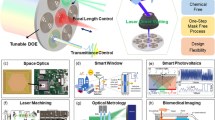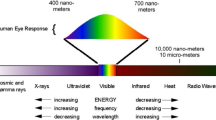Abstract
This study reports the generation of surface plasmon polariton (SPPs) by varied geometrical effects of gold (Au) and silver (Ag) plasmonic grating to realize efficiency enhancement of solar cell by finite elemental analysis (FEA) using COMSOL RF module 5.3a. This technique is quite helpful for far-field and near-field analysis which is required for the confirmation of the excitation of the SPPs. Plasmonic effect can be utilized from metallic materials; the upshot of Au and Ag plasmonic grating assembly upon light absorption in a-Si photovoltaic device has been investigated. In this paper, various plasmonic grating coupling setups for Au and Ag have been designed and studied the transmission spectra with varying grating slit width sizes (80–540) nm and thicknesses 40 nm, 50 nm, and 60 nm but constant periodicity of unit cell (Λ = 720 nm). The slit width of 240 nm nearly one-third of periodicity of the grating is optimum for efficient excitation of the SPPs and hence contributes more for efficiency enhancement of the solar cell. Quite interestingly, resonance wavelength and its variation in full width at half maximum (FWHM) with fixed values of Au and Ag thicknesses has been observed. This paper also reports the study of coupling efficiency for Au and Ag plasmonic gratings. Effective excitation of SPPs inclines toward increased electric/magnetic fields in proximity of slit, henceforth growing the light absorption in substratum. This finding is associated with the existence of strongest plasmonic mode known as fundamental mode/harmonics. Variation in the electric field y-component (Ey) and electric field normal component (E_norm) across cross sectional length of solar cell for Au plasmonic grating with slit thickness of 50 nm has been reported to be efficient in a-Si thin-film solar cell to attain better photoabsorption. This type of geometry can be utilized for solar cells for enhanced absorption of solar spectrum to design an efficient photovoltaic device.












































Similar content being viewed by others
Availability of Data and Materials
All data generated or analyzed during this study are included in this published article.
References
Furlan J et al (198) a-Si versus c-Si material and solar cells similarities and differences. In Proceedings. Electrotechnical Conference Integrating Research, Industry and Education in Energy and Communication Engineering. IEEE
Rao J, Varlamov S (2013) Light trapping in thin film polycrystalline silicon solar cell using diffractive gratings. Energy Procedia 33:129–136
Nakayama K, Tanabe K, Atwater HA (2008) Plasmonic nanoparticle enhanced light absorption in GaAs solar cells. Appl Phys Lett 93(12):121904
Pala RA et al (2009) Design of plasmonic thin-film solar cells with broadband absorption enhancements. Adv Mater 21(34):3504–3509
Shen H, Maes B (2011) Combined plasmonic gratings in organic solar cells. Opt Express 19(106):A1202–A1210
Sarhan AR et al (2020) Modeling of fiber optic gold SPR sensor using different dielectric function models: A comparative study. Plasmonics 15(6):1699–1707
Mills D, Burstein E (1974) Polaritons: the electromagnetic modes of media. Rep Prog Phys 37(7):817
Otto A (1968) Excitation of nonradiative surface plasma waves in silver by the method of frustrated total reflection. Zeitschrift für Physik A Hadrons and nuclei 216(4):398–410
Kretschmann E, Raether H (1968) Radiative decay of non radiative surface plasmons excited by light. Zeitschrift für Naturforschung A 23(12):2135–2136
Ritchie R et al (1968) Surface-plasmon resonance effect in grating diffraction. Phys Rev Lett 21(22):1530
Yang J et al (2011) Plasmonic polymer tandem solar cell. ACS Nano 5(8):6210–6217
Iqbal T et al (2019) Investigation of plasmonic bandgap for 1D exposed and buried metallic gratings. Plasmonics 14(2):493–499
Stepanov AL et al (2012) Synthesis and optical properties of silver nanoparticles in ORMOCER. Appl Phys A 108(2):375–378
Liang D et al (2013) High-Efficiency Nanostructured Window GaAs Solar Cells. Nano Lett 13(10):4850–4856
Isabella O, Krč J, Zeman M (2010) Modulated surface textures for enhanced light trapping in thin-film silicon solar cells. Appl Phys Lett 97(10):101106
Atwater HA, Polman A (2011) Plasmonics for improved photovoltaic devices. Materials for sustainable energy: a collection of peer-reviewed research and review articles from Nature Publishing Group 1–11
Ritchie R (1957) Plasma losses by fast electrons in thin films. Phys Rev 106(5):874
Stern E, Ferrell R (1960) Surface plasma oscillations of a degenerate electron gas. Phys Rev 120(1):130
Powell C, Swan J (1960) Effect of oxidation on the characteristic loss spectra of aluminum and magnesium. Phys Rev 118(3):640
Teng Y-Y, Stern EA (1967) Plasma radiation from metal grating surfaces. Phys Rev Lett 19(9):511
Zayats AV, Smolyaninov II, Maradudin AA (2005) Nano-optics of surface plasmon polaritons. Phys Rep 408(3–4):131–314
Weiner J (2009) The physics of light transmission through subwavelength apertures and aperture arrays. Rep Prog Phys 72(6):064401
Drude P (1900) Zur elektronentheorie der metalle. Ann Phys 306(3):566–613
Zakharian AR, Moloney JV, Mansuripur M (2007) Surface plasmon polaritons on metallic surfaces. Opt Express 15(1):183–197
Sommerfeld A (1899) Ueber die Fortpflanzung elektrodynamischer Wellen längs eines Drahtes. Ann Phys 303(2):233–290
Zenneck J (1907) Über die Fortpflanzung ebener elektromagnetischer Wellen längs einer ebenen Leiterfläche und ihre Beziehung zur drahtlosen Telegraphie. Ann Phys 328(10):846–866
Darmanyan SA, Zayats AV (2003) Light tunneling via resonant surface plasmon polariton states and the enhanced transmission of periodically nanostructured metal films: An analytical study. Phys Rev B 67(3):035424
Raether H (1988) Surface plasmons on smooth surfaces. Surface plasmons on smooth and rough surfaces and on gratings. Springer, pp 4–39
Raether H (1988) Surface plasmons on smooth surfaces. Surface plasmons on smooth and rough surfaces and on gratings 4–39
Palik ED (1984) Handbook of optical-constants 1
Iqbal T (2013) Nanoplasmonic grating coupler for transducer applications. Queen's University Belfast
Iqbal T, Afsheen S (2016) Coupling efficiency of surface plasmon polaritons for 1D plasmonic gratings: role of under-and over-milling. Plasmonics 11(5):1247–1256
O'Connor D (2010) Modelling of nano-optic light delivery mechanisms for use in high density data storage. Queen's University Belfast
Palik ED (1985) Handbook of Optical Constants of Solids (Academic, Orlando). Google Scholar 286–297
Adachi S (1999) Optical constants of crystalline and amorphous semiconductors: numerical data and graphical information. Springer Science & Business Media
Palik ED (1998) Handbook of optical constants of solids. Vol. 3. Academic press
Tang J et al (2011) Cyclosporin A induces cardiomyocyte injury through calcium-sensing receptor-mediated calcium overload. Die Pharmazie Int J Pharm Sci 66(1):52–57
Wang X et al (2011) The application of COMSOL multiphysics in direct current method forward modeling. Procedia Earth Planet Sci 3:266–272
Yee K (1966) Numerical solution of initial boundary value problems involving Maxwell’s equations in isotropic media. IEEE Trans Antennas Propag 14(3):302–307
Bathe M et al (2008) Cytoskeletal bundle mechanics. Biophys J 94(8):2955–2964
Gupta K, Meek J (1996) A brief history of the beginning of the finite element method. Int J Numer Meth Eng 39(22):3761–3774
Carrier D, Dubowski JJ (2009) "Rapid Prototyping" of biosensing surface plasmon resonance devices using COMSOL & Matlab Software. Proc COMSOL Conference
Iqbal T et al (2022) Theoretical study of excitation of surface plasmon polaritons using silver metal. Plasmonics 1–11
Ferry VE et al (2008) Plasmonic nanostructure design for efficient light coupling into solar cells. Nano Lett 8(12):4391–4397
Acknowledgements
The authors express their gratitude to the Deanship of Scientific Research at King Khalid University for funding this work through research groups program under grant number R.G.P. 2/151/43.
Author information
Authors and Affiliations
Contributions
All authors contributed to the study conception and design. Material preparation, data collection, and analysis were performed by Muzafer Iqbal. The first draft of the manuscript was written by Muzafer Iqbal and Muhammad Abrar, Irfan Ahmed, M. A. Sayed, A. F. Abd El-Rehim, and Atif Mossad Alicommented on previous versions of the manuscript. Muhammad Abrar and Tahir Iqbal supervised and authenticated the data. All authors read and approved the final manuscript.
Corresponding authors
Ethics declarations
Ethical Approval
Not applicable.
Consent to Participate
Not applicable.
Consent to Publish
Not applicable.
Competing Interests
The authors declare no competing interests.
Additional information
Publisher's Note
Springer Nature remains neutral with regard to jurisdictional claims in published maps and institutional affiliations.
Rights and permissions
Springer Nature or its licensor (e.g. a society or other partner) holds exclusive rights to this article under a publishing agreement with the author(s) or other rightsholder(s); author self-archiving of the accepted manuscript version of this article is solely governed by the terms of such publishing agreement and applicable law.
About this article
Cite this article
Iqbal, M., Abrar, M., Iqbal, T. et al. Plasmonic-based Solar Cell: Geometrical Optimization of 1D-nanostructured Grating for Enhanced Efficiency. Plasmonics 17, 2491–2520 (2022). https://doi.org/10.1007/s11468-022-01717-5
Received:
Accepted:
Published:
Issue Date:
DOI: https://doi.org/10.1007/s11468-022-01717-5




